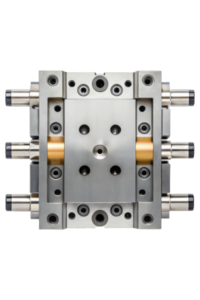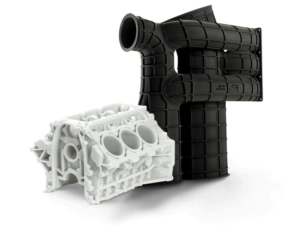by Vince Caltabiano
In order to explain the evolution of “High Resolution” SLA printing we first need to establish some common knowledge…
Picture the “image plane” in an SLA machine. The image plane is the resin surface that the laser draws on. Resolution has two aspects: layer thickness and beam diameter.
Layer Thickness
Layer thickness determines the “stair stepping” on the sidewall of a part. Since SLA is an additive layer process the stair stepping will be more apparent with a larger layer thickness e.g., 0.004” layer will be more apparent than a 0.002” layer. Keep in mind this has little relevance to small features as it is mainly only relevant to sidewall “smoothness”. Bear in mind that smoothness can be somewhat irrelevant as well if the part is sanded or bead blasted, in other words post process finishing contributes to sidewall quality.
Beam Diameter
Laser beam diameter determines how small of a feature can be built in any given layer. In the past standard laser beam size was 0.010” diameter. Newer SLA systems (e.g. 3D Systems ProX 800) are now standard with a 0.005” beam diameter. Thus, by legacy standards the newer SLA systems print in what used to be known as a hi-res mode.
“Hi-Res” or high resolution would have either been a 0.005” beam diameter (users of 3D Sprint can see this referred to as UHD or Ultra High Resolution) OR a 0.003” beam diameter (users of 3D Sprint can see this referred to as XHD or Extreme High Resolution).
In general, feature size is dictated by the beam diameter so any feature smaller than the beam size will not be apparent (note that there are some set-up parameters that can help preserve small features should they be slightly smaller than beam diameter). Think of trying to draw a hair size line with a Sharpie marker that has a fat tip. This analogy is pretty accurate when considering SLA capability for creating hi-res parts. While using a thin layer thickness to reduce the appearance of stair stepping on sidewalls in addition to a small beam diameter to preserve small features in each layer (this is your fine point Sharpie) you have a “hi-res” part in all its grandeur.
One last factor to note: DLP 3d printers also offer very impressive resolution utilizing an HD projector in place of the traditional UV laser found in typical stereolithography. Learn more about our DLP printing capabilities.
If you have a 3D printing project that you need created now, contact an expert or begin your project online today.


